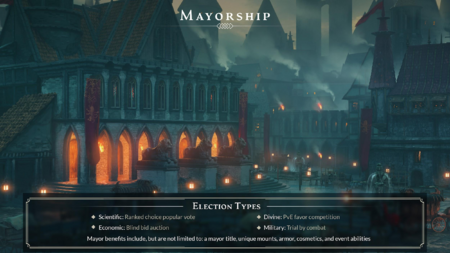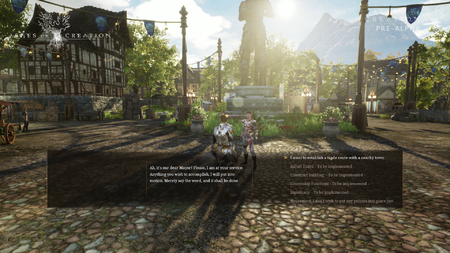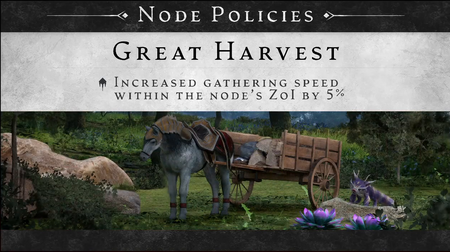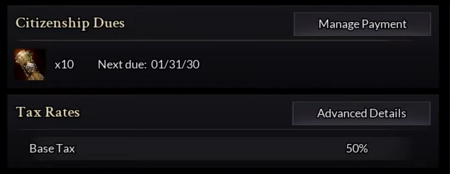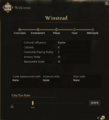Node governments
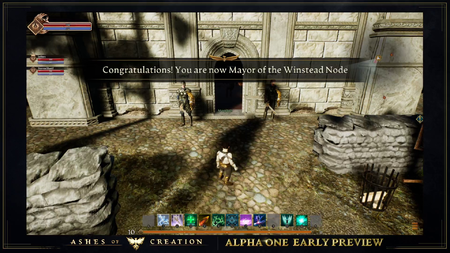
There are a number of different seats that can exist within a node, and carry different responsibilities.[2] – Steven Sharif
Positions within a node's government are attained through seasonal titles that grant special powers and benefits within the node.[3][2][4][5]
There are other node-based positions. Most of them relate to social organizational structures like the temple and the social organization building that the node might construct. Those are ladder systems of achievement that players can work through on a seasonal basis to achieve the highest level of that for the particular node; and by doing so they will then have titles bestowed upon them, which grants certain types of powers and benefits.[3] – Steven Sharif
- Mayors.[6]
- Priests, bishops, or acolytes of temples.[3][7][4]
- Social organization positions.[3]
- Patron guild leaders.[4]
- Chief bounty hunter.[4]
Node elections
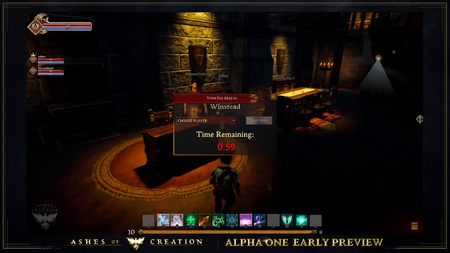
The village stage is a unique stage because that's when the government system comes online and all other stages past village there will have already been a cadence for the election system and it will follow that cadence, but after the initial village stage is completed there will be a one week period where players have an opportunity to establish citizenship at the village that also provides for the cooldown time that is- that would be present on players leaving another node to participate in in this particular node leveling up. But that after that one week period then there will be a one-week election process and then from that point moving forward will be the one month cadence that the node experiences elections on.[9] – Steven Sharif
Once a node has reached Village (stage 3) there will be a one week cooldown period before node elections begin.[9]
- This cooldown period allows players to establish citizenship at the village; which may require them to relinquish previous citizenship at another node.[9]
- Following the initial cooldown, there will be a one week election process, then from that point on, elections will follow a monthly cadence.[9]
- Node sieges may not be declared for 21 days following a node advancing to any stage.[10]
Node elections occur on a monthly basis.[9][12]
- Election notices will be mailed to the accounts of citizens.[13]
- Only citizens of a node may participate in its elections.[5]
- Only node citizens may be elected mayor.[14]
- A king or queen can also become a mayor.[14]
Node election types
Mayors are chosen through different methods according to the node's type.[18][19]
- Divine node mayors are elected based on the citizen who earns the most PvE favor with the node.[16][17][20][18]
- Most of the devotion-oriented tasks are going to be on an individual basis and won't utilize outside support.[21]
- Economic node mayors are elected via a blind-bid auction where the citizen bidding the most money wins.[16][17][20][18] This is a gold sink.[22]
- Military node mayors are elected based on trial by combat. During the election week the node will enter an open-PvP battleground state for hour-long periods where candidates (and their citizen supporters) compete to gain points by securing objectives. The highest point winner at the end of the week will win.[16][17]
- Academic node mayors are elected via ranked choice popular vote.[16][17]
- This was previously a single popular vote system.[20][18] Records of who voted for who are not published.[13]
City hall
Town hall (also called City hall) is a default service building that comes pre-built with nodes.[30][16][31][29]
- Players can interact with the node board to get a list of its citizens.[13] Clicking on a citizen will reveal information about their guild, society, religion, and property ownership.[13]
- Mayors and node governments use city hall to visualize and control activities within their node. These capabilities will also be available via mobile/web interface.[6]
- Status of the node's economy.[6]
- Status of upcoming elections.[6]
- Status of trade agreements.[6]
- Status of caravans.[6]
Mayors
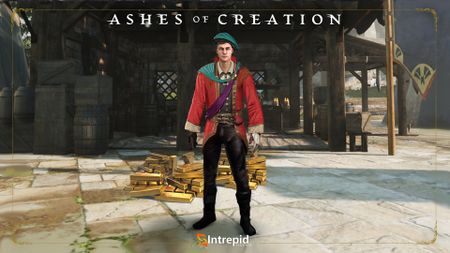
Mayors have a unique ability to elicit change within the node proper, either through the destruction of certain buildings that have been constructed previously, because there's a limited number of slots that buildings can be constructed within, or the kickoff of additional projects, or the certain types of policies that can be enacted, like... the changing of a tax rate. They all have a unified source of energy requirement and the energy requirement is a mandate.[33] – Steven Sharif
Mayors are chosen through different election methods according to the node's type.[18][19]
- Only node citizens may be elected mayor.[14]
- Previous mayors won't have any special system driven bonuses to help them get reelected.[34]
- Kings and Queens can also become a mayors.[14]
- Mayoral leadership powers are granted via the use of mandates.[33][6]
- Players will be able to view a historical listing of mayors of a node.[35]
Mayoral caravans
Mayoral caravans (also referred to as Trade caravans) are launched by Mayors to obtain needed resources from other nodes.[37][38][36]
- Nodes answering these resource requests must have a trade agreement or alliance with the requesting node.[38][36][29]
- Once the requesting mayor accepts a fill order from another node, a system driven caravan is spawned to transit the goods.[38][36]
- Players can participate in helping to defend the caravan if they wish.[38]
- Trade caravans can initiate world events.[37]
- Mayors who need certain resources that either they don't have enough of, or that they're prospectively investing in: they will initiate a mayor request, and any node that sees that request on the mayoral caravan drop-down menu will have an opportunity to attempt to fulfill the trade request. In order to fulfill a trade request, a node must have a certain level of relationship with that requesting node. At a minimum it has to be a trade agreement relationship; and then there's a limited number of those trade relationships that you can have; and that scales up to eventually alliance perspective. And then, once the node requesting mayor accepts a potential fill order, then a system spawned caravan is generated and the transit is completed. Players can participate in helping to defend that or not.[38] – Steven Sharif
Leadership powers

The government has a lot of say in the direction of the node's development. Directing assets, building projects, tax allocation, defensive ability etc. Players have the ability to not only create these cities, but they have the right of self-governance.[5]
Mayoral leadership powers are granted to mayors via the use of mandates.[33][6]
- Initiate buy orders using gold from the node treasury.[16][40][41][42]
- Initiate mayoral commissions to aid node development.[16][43][41][33][44][5]
- Adjust node taxes.[16][33][45] This includes setting tax rates that apply to tavern games.[46][47]
- Tax money may only be used to fund node development.[48]
- Initiate service building construction and expansions.[16][33]
- Improving node defensive structures, such as stronger walls and gates, traps, and siege equipment.[44][49][50][51][5]
- Hiring mercenary NPCs to defend the node during sieges.[52][5]
- Set a message-of-the-day for the node.[53]
- Proposing node policies that are voted on by citizens.[54][55][44]
- Mayors won't have formal systems to carry out surveys/polls of node citizens, but they will be able to utilize node citizen chat or message-of-the-day services.[53]
- Mayors may have special color names in node chat channels.[53]
- Entering into trade agreements with other nodes.[16][54][29]
- Mayors cannot denote players as enemies of the state.[57] Previously this was a potential option.[29][58]
- Mayors are notified when their node is named on a siege declaration scroll.[59]
- Mayors and lords of castles have spells they can use on the battlefield with high effect and long cooldowns for their teams.[60]
- Mayors gain new powers and responsibilities as their node advances.[19]
- Some leadership powers are specific to node type, biome, or dominant race, others are universal.[62]
- There definitely are differences... Some of the things that mayors can do are more universal, but then some systems have very specific if your node has a certain dominant race, or your node is a certain type, or it's in a certain biome. So there's even differences between where it is too.[62] – Chris Justo
- If a mayor does not make certain decisions within a set period of time then the system will make a decision for them.[64][65]
- Q: The idea behind all these nodes are awesome, but I wonder how it will actually play out in the live version. The problem is having player run or the problem with having player run towns is that people come and go in video games. So, will towns die out etc?
- A: We incorporate as part of those designs certain fail-safes, certain protections, certain automated progression that takes over when some of those decisions are lacking or are not made; and those decisions can be defaulted. Now, of course, that would have a deleterious effect on the direction that a particular node might want to go, because they're going to be doing default behaviors, or default actions, as opposed to something that might be in line with the strategic objective of that particular node, or the specialization that the node has previously been attempting to do. But that is why we have a regularly recurring election period where players can take the reins of power and can elect someone else to come in and participate and and re-right the ship, so to speak. So it is absolutely a component of having player-driven mechanics that there is an opportunity for things to be less than ideal, or less than strategic when certain bad-faith actors or people leave, but there are safeguards in place.[64] – Steven Sharif
Node policies
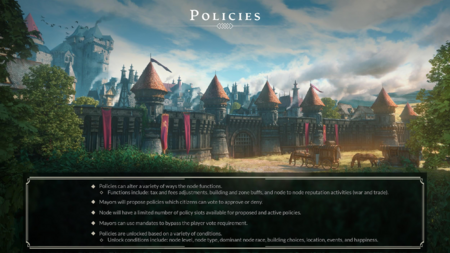
Nodes have a number of slots that they get to employ as Government policies that are enacted and chosen by the mayor and voted on by the people; and certain policies get unlocked by certain happiness states of the factions within the node; and those happiness states are predicated across different achievements that can happen in the world story arcs that get finished; bosses that get killed around you; new buildings that get constructed: Lots of different things can contribute to that happiness value: Number of citizens; number of citizens you've had leave; number of houses that might have been foreclosed upon. There's lots of different things that influence it, but when the happiness is met at a certain point- and even without that happiness you can still have policies that you get to enact regardless. You may choose policies that do certain things for the node; and this is a big strategic decision that the node has to almost agree on because it's voted on by the citizens within a short time period, but elected by the outstanding mayor; and when you deploy a policy it confers benefits to the citizens, or to the area, or to specific buildings, or to the mayor.[55] – Steven Sharif
Node policies affect a variety of node functions, such as taxes and fees, building and zone buffs, and node-to-node reputation activities, such as trade agreements, and node wars.[16][54]
- Mayors propose node policies that are voted on by citizens within a 24-hour or shorter time period.[16][54][55][44]
- Policies are voted in if the majority of voters approve of them.[70]
- Mayors can utilize their available mandates to bypass policy votes.[16][54][33]
- Mayors may also be able to take emergency actions depending on certain predicates that get met. This might allow them to reduce the voting threshold or voting time for policies.[70][55]
- There are a limited number of policy slots available to be proposed.[16][54] Some policies occupy multiple slots.[55]
- Node policies that are deployed will provide benefits to various aspects of the node, its citizens, its ZOI, its vassals (in some cases), specific buildings, and to its mayor.[70][55]
- Certain policies may affect the visual appearance of the node.[71]
- Some of the benefits you can receive by being a vassal of a certain parent is access to a policy that your node not might not normally have access to; and in fact you can also unlock an additional policy slot based on certain conditions that the parent or Sovereign node may have access to in their reliquary, or in their achievement systems, or in policies that they've elected. Some policies occupy multiple slots and it's almost like a card structure. You have each of these policies that live on a card and you get to select that card- throw it into the slot it goes out to the citizens to vote on within the 24-hour or sometimes shorter period. The mayor has emergency actions they can take right depending on certain predicates that get met and if an emergency action occurs they may be able to spend their influence as mayor within their term to set up a policy for a vote within an hour's period of time; and citizens in that way they can sneak it through a bit.[55] – Steven Sharif
Policies are unlocked by various conditions within a node.[16][54][55][44]
- Node level.[16][54]
- Node type.[16][54]
- Dominant node race.[16][54][55]
- Building choices.[16][54][55]
- Location of the node.[16][54]
- Events, such as node wars and node sieges.[70][16][54]
- Node happiness.[16][54][72][73]
- Achievements based on the completion of story arcs.[55]
- World bosses that are defeated.[55]
- Node citizens gained (or lost).[55]
- Node housing foreclosed upon.[55]
- There's a lot of different things that policies can influence; and policies exist within certain denominations. You have some policies that might be reflective of the culture that the node is representing; and you get access to those cultural policies. You have some policies that might become available because you've constructed a certain building type and now you've attracted a guild of NPCs that are weapons smiths. You might have some policies that are social organizations representative- you only get to build one social organization or Temple: which religion does the node follow. All of these are customization points that the city gets to choose and now you as a citizen get to identify the city that best aligns with your progression within the game and your game style and gameplay.[55] – Steven Sharif
Node layout and style
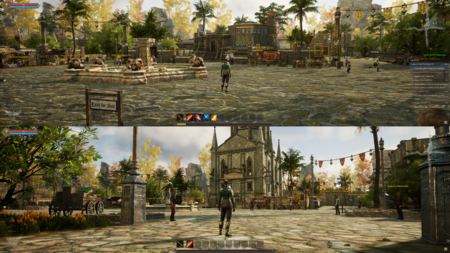
The layout and architecture within a Node’s development area are determined by influential race. For example, a stage 3 Node with the majority of player contribution being Py'rai would have a Py'rai village with Py'rai architecture. Most NPCs would be Py'rai elves, and offer questlines within the Py'rai narrative.[19] – Margaret Krohn
Each player’s contributed experience is flagged with their character race and other identifiers. When a Node advances, the race with the highest experience contribution determines the Node’s style and culture. This style and culture change can happen at every Node Stage. For example, if a Node advances to Level 2 - Encampment Stage and 51% of all experience was earned by Ren’Kai players, the Node will be a Level 2 Ren’Kai Node. If that same Node advances to a Level 3 - Village Stage Node, but the Py'Rai contributed 62% of all the experience earned, then the Node will be a Level 3 Py'Rai Node.[74] – Margaret Krohn
Node layout and style is determined by several factors:[75][76]
- The way that the node system is built is that they can exist across a spread of 18 biomes, but at the same time have to represent the cultural influence of these cultures that are intrinsically a part of a specific biome.[77] – Steven Sharif
- Environment (biome) and location of the node.[77][75][76]
- Nodes will adjust the local topography to fit the aesthetic and mechanical requirements of the node.[78]
- Currently the way that the platform system is set up, is it's capable of adjusting the topography of the node's footprint, regardless of the surrounding terrain. So the reason for that is we want to have flexibility in the presentation of the node's layout and how it is essentially both from an aesthetic standpoint as well as a mechanical standpoint with node sieges- how it's constructed and that construction should have the ability to take on a variance of different types of topography. So it shouldn't be dependent on the surrounding area. Now that's not to say that the surrounding area isn't going to have some influence over. So for example... we're experimenting a little bit with the platform tech and putting up a node up against the side of a mountain or on the edge of a cliff or something that has a beautiful vista. Those are things that we're going to test out obviously as we continue to work on the node tool and how that platform system works, but the idea is to have the node independent of the surrounding terrain.[78] – Steven Sharif
- Some parts are determined by the area it's in. Some parts are determined by the type it is. Some parts are determined by the race it is; and then the rest of it is determined by the mayor.[76] – Jeffrey Bard
- Race that contributed the highest percentage to the node's advancement will alter the racial appearance of its buildings, NPCs, and props.[79][80][75][74][76][81][82]
- All nodes, whether they're associated with a castle or associated with normal node structure, has cultural influences that replicate over to the buildings that are produced and the NPCs that are present.[84] – Steven Sharif
- The rest is determined by the node's mayor.[76]
- It should be possible for a node to complete several building projects within a mayor's one month term in office.[85]
- Q: How long would you say it will take players on average to fill/build up a node completely from wilderness to metropolis?
- A: It's one thing to get a node to a certain level: it's another thing to develop the node; and I can't really give you an on-average expectation, because there's a lot of variables at play. There's how many citizens does the node have attracted to it; what's the type of traffic that the node is attracting to it based on things like its tax rates, or the specialization that it chose to spec into, based on the building types it's chosen to build. All of those things are variables that can affect the quote-unquote "average build-out time" of a particular node. So it's difficult to give you an average when there's so many variables along those lines. But the idea is that if there is a particular project that players are interested in in developing based on the node stage, that they would have the ability to complete several of those projects as within a single term of a mayor; and a term of a mayor is one month.[85] – Steven Sharif
Cultural influences
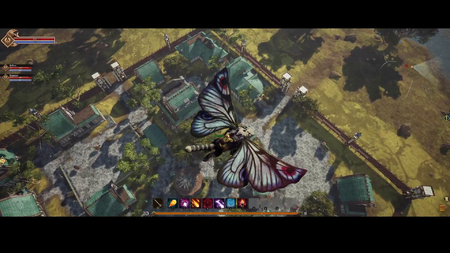
We have essentially sets that exist across all races; and each race that dons those armor sets is going to have their own racial influence on the presentation of those particular sets. So that's something that's unique in how each of the races get diversified. Additionally, the more that one particular race contributes to a node's development, it's going to manifest in that particular node's architectural influences. You're going to see the architectures of those races become manifest within the nodes as well: That's another way that we diversify each race and we present each race's culture in the game as through those architectures, through those props that exist, through the tailoring of the armor sets that the NPC might wear, to the different factions that exist. Factions will have their own affiliation with different races as well. Each race will also have some different nomenclature when it comes to the lore, or comes to locations in the world. They're going to have their own language influences as well: The way they speak is something that's going to be distinct between races; when you have dialogue trees with particular NPCs. So all of those things really go into setting an immersive world where the cultures have their own identity.[79] – Steven Sharif
Cultural influences manifest in many ways, from node and gear aesthetics to NPC languages and lore.[79][87][74]
- Gear appearance of certain armor sets is influenced by the player's race.[79]
- Node layout and style is influenced by the race that contributes the most to that node.[79]
- There is an attrition and that attrition on experience and influence is heightened based on the performance of the race in the world. So if all these nodes are Orc nodes then their attrition rate is very high to compete with the cultural establishment of new nodes because they have more influence in the world and a popular opinion is against them in their outlying regions that they do not have influence in.[88] – Steven Sharif
Constructible node buildings
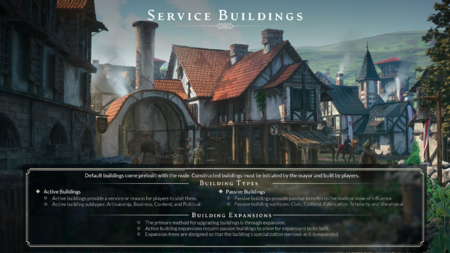
The important thing with the service building system for us is that it's a way to shape your node like a character; and to give you an exclusive niche that you can carve out in the world; or a niche that you fight over. If you go down this weaponsmithing path and you build your node to be this mecca of weaponsmithing and the node three doors down builds it, there's reason for you to conflict over it. They're taking your business. Or maybe you are in a zone and there isn't a weaponsmithing thing anywhere near you, and you do want to start to carve that path for yourself to make your node a place people visit and come to.[31] – Chris Justo
Service buildings within a node are either default buildings that come with the node, or they are constructed buildings, which are initiated by the mayor and built by players.[16][31][89][90][91][92][93] Service buildings are further broken down into two main types:[16][31]
- Active service buildings are service buildings that players directly interact with. These are further broken down into Artisanship, Business, Content, and Political categories.[16][31]
- Passive service buildings provide passive benefits to the node or its zone of influence. These buildings are broken down into Civic, Cultural, Fabrication, Scholarly, and Vocational.[16][31]
- Constructed service buildings are available to every type of node in every location. Where the uniqueness comes in is in some of the default buildings like your node-type building.[94] – Chris Justo
Service buildings are upgraded by expansions, which are unlocked through the placement of passive service buildings.[16][31]
- Building expansions unlock higher tier workstations at the cost of dedicating service building plots.[95][91]
- Node service building expansions specialize the building through a tech tree based on the stage of the node.[96][97]
Service buildings incur a regular maintenance cost of node commodities and gold from the node treasury in order to continue operations.[16][98]
NPC racial interaction
- NPCs will react differently to different character races.[99]
- Languages will be distinct between NPC races and in the lore.[79]
- Certain quest givers and NPCs may only be present at nodes with certain cultural influences.[100]
- Depending on the cultural influence of the node activates certain types of quest lines and/or sponsors. Some of those are shared, some of those are general. Some of those relate to a progression path that is a first time user experience. Those will be constant across all culture types. Some of them, however, are predicates that spawn when certain story arcs and/or events, or commissions or buy orders become present within the node; and those might change based on the cultural influence of the node. So there is a separation between those populations.[100] – Steven Sharif
Node sieges
As some areas in the world grow, others will fall. This is the foundation of the living, breathing world that is Ashes of Creation, where players will have the ability to make important decisions that matter in the longevity of an area becoming a city, or whether to siege a rival town. Rise above the ashes, create the world around you, and be a part of the story that unfolds because of your actions and decisions.[74] – Margaret Krohn
Node sieges enable players to destroy nodes starting at Village (stage 3).[74] This paves the way for new development and access to the locked content in surrounding nodes. Due to this dynamic, political strife and intrigue play an important role in the structure of the world.[102]
- Sieging nodes will not be an easy task for the attackers. Cities and metropolises will have a considerable defensive advantage.[102]
- There will be systems that mimic some of the mechanics of sieges, but there won't be practice sieges.[103]
- Death penalties do not apply to objective-based events such as node sieges.[104]
- If you own a home in a node and you don't want to see that home destroyed, you need to defend that city![105] – Steven Sharif
- The majority (~80%) of content in Ashes of Creation is open-world but there may be instanced battles within castle and node sieges where specific groups can participate in small, short-duration objective-based battles for specific waypoints.[106]
Node wars
Node governments may declare war on another node and rally citizens to the cause.[44][29]
- This mutually flags the citizens of the warring nodes, including their allies, as combatants.[107]
- Social organizations quests will either be cooperative or adversarial based on the war status of their parent nodes.[107]
- Vassal nodes cannot declare a node war on their parent node or any of their vassals.[19]
- Node wars can be declared at any time, but the objectives will only spawn during server prime-time.[108]
- Players can kill each other at any time during the war (not only during server prime-time).[108]
- Node wars affect reputation between the nodes.[16][54]
- We have conditions that you can set between nodes with regards to either nodes being friendly with each other and acting trade alliances, or they can declare war on nodes similar to how guild wars may function in different games, where those citizens become hostile to each other based on the player government that's elected in the particular node. So those systems all cater to allowing a conflict that's meaningful and that also provides a non-imbalanced relationship between stronger guilds and not as strong guilds.[109] – Steven Sharif
Node politics
There won't be a civil war mechanic within nodes but there will be scope for internal political conflicts; such as undermining the current leadership and disrupting trade.[110]
- The only way to remove an elected mayor prior to the end of their term is by destroying the node.[111]
We want consequences to matter and if that person got elected then you need to work within the means of the mechanics to get them unelected.[111] – Steven Sharif
Trade agreements
Mayors can enter into trade agreements with other nodes to facilitate trade between the nodes.[38][36][29]
- There are a limited number of trade agreements that a node can have.[38]
- Mayoral caravans may only be initiated between nodes with trade agreements or alliances.[38][36]
- Trade agreements affect reputation between the nodes.[16][54]
- Mercenary guilds will be a viable way forward for different organizations. I think there will be a lot of business to be had with that; and one of the systems in our trade agreements is creating an escrow for those particular type of arrangements that we're looking into.[112] – Steven Sharif
Trade routes
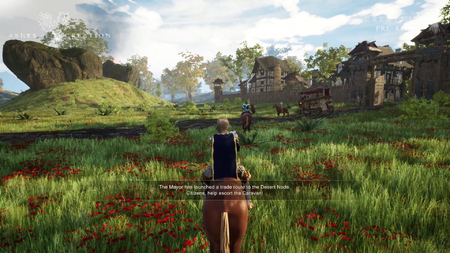
For example: this node over here might have access to cotton as a resource and when that node processes that cotton it might be some very nice type of linen that only that node, or very rarely nodes would have access to. So when you initiate a trade route, you're bringing its supplies that the mayor has requested because they're trying to build, let's say a specific type of service building, or they're trying to unlock a blueprint that they have access to now to build up their node.[113] – Steven Sharif
Trade routes in Ashes of Creation refer to.
- Roads for the transit goods via the caravan system.[114]
- You might have a mountain pass and during winter that mountain pass is always closed and so the trade routes on land change with caravans and that's something that can not only exist on a cyclical level but also dynamically based on player activity.[114]
- Economic relationships between nodes established by Mayors or node citizens.[113][36]
- Agreements are established to trade commodities that are unique to particular nodes or node types via NPC-driven caravans.[113][36]
- From a diplomatic standpoint the ability for the mayor or citizens to set up NPC routed trade routes between nodes as a trade agreement or as a diplomatic process.[113] – Steven Sharif
Taxation
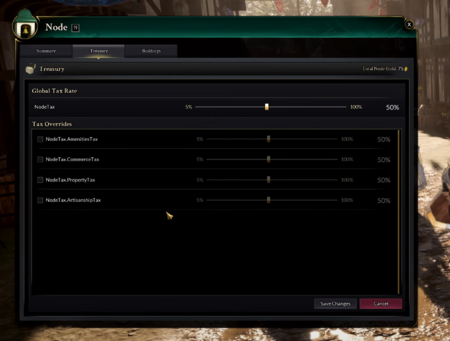
As the node levels up, you're gonna get access to deeper controls on the taxes, so that you as a Mayor can incentivize players to come to your node to do certain things. If you're a node that loves smithing, you're probably going to want to lower your taxes on artisanship to incentivize players to be here. But then you might want to drive up taxes on other avenues that players aren't necessarily coming to your node for, but are using out of convenience.[117] – Chris Justo
Mayors are able to set a generalized node tax rate as well as overrides for different activities within their node. Mayors gain additional taxation controls as their node advances.[117][45]
- Amenities tax override.[117]
- Artisanship tax override.[117]
- Commerce tax override.[117]
- This may include taxes that apply to tavern games.[46][47]
- Property tax override.[117]
- Freehold property taxes scale according to the number of freehold building permits issued for that freehold.[118][119][48]
- Citizenship dues and property taxes scale based on the stage of the node when a player became a citizen.[16][120][121][122][109]
- The goal is to exert financial pressure on node populations by making taxes increasingly expensive as nodes advance, rather than putting in place hard population caps.[121][122]
- Node tax rates will be visible on the world map by hovering over a node location.[123]
- Tax revenue only goes toward funding node development. This cannot be withdrawn by the mayor or any other player.[124][48]
Regent nodes take a cut of taxes from various activities that occur within their vassal node structure.[124][125]
- This tax doesn't necessarily impact the individual citizen, because citizen's tax levels are determined by their node, but the node's finances are affected by the taxation levied by its parent nodes.[125]
When a node reaches stage 3 (Village) and a player run government has formed, all player housing will pay taxes.[126]
- A player's tax charge will be determined by the number of structures built on their plot.[119][48]
- Freehold taxes are calculated based on the number of permits issued for buildings on a freehold.[127][128][118][119][48]
- Buildings that require permits will have additional upkeep costs.[127]
- Maintaining businesses requires licensing and payments to the node your Freehold is associated with. This permitting system allows for a certain number of buildings to be constructed on a Freehold. Permits can be obtained from the same node the Freehold was certified from, and buildings that require permits will have an additional upkeep cost.[127]
- Housing foreclosures result from failing to pay property taxes or other fees.[127]
Visuals
See also
References
- ↑ Livestream, March 28, 2020 (1:02:46).
- ↑ 2.0 2.1
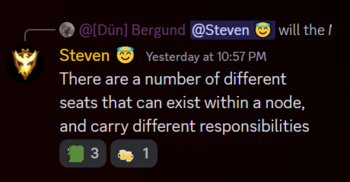
- ↑ 3.0 3.1 3.2 3.3 Livestream, September 29, 2023 (1:07:01).
- ↑ 4.0 4.1 4.2 4.3 Livestream, July 26, 2019 (1:20:48).
- ↑ 5.0 5.1 5.2 5.3 5.4 5.5 5.6 5.7 5.8 MMOGames interview, January 2017
- ↑ 6.0 6.1 6.2 6.3 6.4 6.5 6.6 6.7 Livestream, November 17, 2017 (9:49).
- ↑ 7.0 7.1 Livestream, July 25, 2020 (1:52:45).
- ↑ Livestream, March 28, 2020 (1:01:34).
- ↑ 9.0 9.1 9.2 9.3 9.4 Interview, March 27, 2020 (6:03).
- ↑
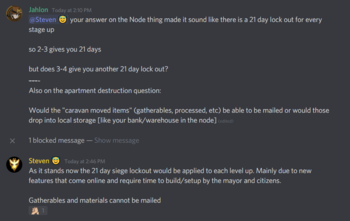
- ↑

- ↑

- ↑ 13.0 13.1 13.2 13.3 Livestream, October 30, 2020 (1:01:00).
- ↑ 14.0 14.1 14.2 14.3 14.4 14.5

- ↑ 15.0 15.1 Interview, May 11, 2018 (50:05).
- ↑ 16.00 16.01 16.02 16.03 16.04 16.05 16.06 16.07 16.08 16.09 16.10 16.11 16.12 16.13 16.14 16.15 16.16 16.17 16.18 16.19 16.20 16.21 16.22 16.23 16.24 16.25 16.26 16.27 16.28 16.29 16.30 16.31 16.32 16.33 Blog: Development Update with Village Node.
- ↑ 17.0 17.1 17.2 17.3 17.4 Livestream, August 31, 2023 (24:54).
- ↑ 18.0 18.1 18.2 18.3 18.4 Node series part II – the Metropolis.
- ↑ 19.0 19.1 19.2 19.3 19.4 Blog - Know Your Nodes - The Basics.
- ↑ 20.0 20.1 20.2 20.3 Interview, July 19, 2020 (26:54).
- ↑ Livestream, March 26, 2021 (1:18:26).
- ↑ Livestream, October 31, 2023 (1:35:22).
- ↑ Livestream, November 19, 2021 (51:56).
- ↑

- ↑ Interview, March 27, 2020 (09:05).
- ↑ Livestream, March 26, 2021 (1:17:20).
- ↑ Podcast, May 11, 2018 (52:20).
- ↑ Video, August 31, 2023 (49:05).
- ↑ 29.0 29.1 29.2 29.3 29.4 29.5 29.6 29.7 City hall.
- ↑ Video, August 31, 2023 (33:07).
- ↑ 31.0 31.1 31.2 31.3 31.4 31.5 31.6 31.7 Livestream, August 31, 2023 (50:25).
- ↑
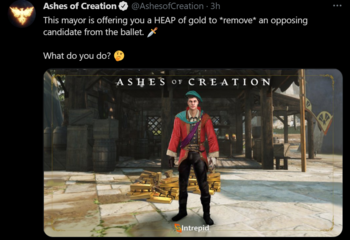
- ↑ 33.0 33.1 33.2 33.3 33.4 33.5 33.6 Livestream, August 31, 2023 (31:44).
- ↑ Livestream, August 31, 2023 (37:35).
- ↑ Livestream, September 29, 2023 (1:05:44).
- ↑ 36.0 36.1 36.2 36.3 36.4 36.5 36.6 36.7 36.8 Video, July 15, 2019 (2:12).
- ↑ 37.0 37.1 Video, September 29, 2023 (2:59).
- ↑ 38.0 38.1 38.2 38.3 38.4 38.5 38.6 38.7 Livestream, August 31, 2023 (2:10:23).
- ↑ Livestream, December 12, 2018 (14:48).
- ↑ Livestream, August 31, 2023 (59:43).
- ↑ 41.0 41.1 Interview, July 8, 2020 (1:04:05).
- ↑ 42.0 42.1 Livestream, June 30, 2017 (53:57).
- ↑ Livestream, August 31, 2023 (39:17).
- ↑ 44.0 44.1 44.2 44.3 44.4 44.5 44.6 Livestream, April 29, 2022 (27:42).
- ↑ 45.0 45.1 Livestream, March 28, 2020 (1:03:38).
- ↑ 46.0 46.1

- ↑ 47.0 47.1

- ↑ 48.0 48.1 48.2 48.3 48.4

- ↑ Livestream, July 25, 2020 (1:22:40).
- ↑ Livestream, January 18, 2018 (37:05).
- ↑
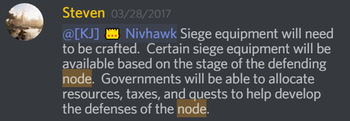
- ↑ Livestream, June 26, 2020 (59:11).
- ↑ 53.0 53.1 53.2 Livestream, August 31, 2023 (35:23).
- ↑ 54.00 54.01 54.02 54.03 54.04 54.05 54.06 54.07 54.08 54.09 54.10 54.11 54.12 54.13 54.14 54.15 54.16 Livestream, August 31, 2023 (44:21).
- ↑ 55.00 55.01 55.02 55.03 55.04 55.05 55.06 55.07 55.08 55.09 55.10 55.11 55.12 55.13 55.14 55.15 Livestream, August 26, 2022 (1:12:40).
- ↑ Livestream, August 31, 2023 (29:04).
- ↑ Livestream, August 31, 2023 (30:41).
- ↑

- ↑ Livestream, December 23, 2021 (1:30:34).
- ↑ 60.0 60.1

- ↑ Livestream, August 31, 2023 (41:15).
- ↑ 62.0 62.1 Livestream, August 31, 2023 (28:30).
- ↑

- ↑ 64.0 64.1 Video, September 29, 2023 (1:52).
- ↑ Livestream, August 31, 2023 (29:33).
- ↑

- ↑ Livestream, May 19, 2017 (36:05).
- ↑ Livestream, May 19, 2017 (36:09).
- ↑
- ↑ 70.0 70.1 70.2 70.3 Livestream, August 31, 2023 (47:43).
- ↑ Livestream, August 31, 2023 (49:13).
- ↑ 72.0 72.1 Livestream, April 7, 2023 (1:19:41).
- ↑ 73.0 73.1 Livestream, August 26, 2022 (1:17:04).
- ↑ 74.0 74.1 74.2 74.3 74.4 74.5 Blog - Know Your Nodes - Advance and Destroy.
- ↑ 75.0 75.1 75.2 Livestream, October 30, 2020 (39:17).
- ↑ 76.0 76.1 76.2 76.3 76.4 76.5 Livestream, September 27, 2018 (53:06).
- ↑ 77.0 77.1 Livestream, February 25, 2022 (41:00).
- ↑ 78.0 78.1 Livestream, February 26, 2021 (1:12:18).
- ↑ 79.0 79.1 79.2 79.3 79.4 79.5 Livestream, March 31, 2022 (4:57).
- ↑ Podcast, April 11, 2021 (29:47).
- ↑ Interview, May 11, 2018 (54:34).
- ↑ Livestream, May 26, 2017 (21:23).
- ↑ Podcast, April 11, 2021 (23:36).
- ↑ 84.0 84.1 Interview, May 11, 2018 (47:27).
- ↑ 85.0 85.1 Livestream, July 29, 2022 (1:13:09).
- ↑ Livestream, June 26, 2020 (45:32).
- ↑ 87.0 87.1 Interview, February 7, 2021 (33:00).
- ↑ 88.0 88.1 Interview, May 11, 2018 (1:00:19).
- ↑ Video, August 31, 2023 (2:59).
- ↑ Interview, July 9, 2023 (1:32:45).
- ↑ 91.0 91.1 Livestream, May 19, 2017 (33:57).
- ↑ Livestream, January 20, 2018 (38:17).
- ↑ Livestream, 2018-04-8 (PM) (51:49).
- ↑ Livestream, August 31, 2023 (56:18).
- ↑ Livestream, August 31, 2023 (52:56).
- ↑ Video, August 31, 2023 (34:37).
- ↑ Livestream, March 31, 2022 (1:13:00).
- ↑ Livestream, August 31, 2023 (57:23).
- ↑ 99.0 99.1 Podcast, April 23, 2018 (29:56).
- ↑ 100.0 100.1 Interview, July 9, 2023 (1:35:28).
- ↑ Video, December 4, 2016 (0:02).
- ↑ 102.0 102.1 A reactive world - Nodes.
- ↑ Twitch Bustin - Practice Sieges?
- ↑ Livestream, December 22, 2020 (1:13:51).
- ↑ Video, April 30, 2017 (5:31).
- ↑ Livestream, January 28, 2022 (17:50).
- ↑ 107.0 107.1 Interview, July 19, 2020 (24:34).
- ↑ 108.0 108.1

- ↑ 109.0 109.1 Video, April 5, 2018 (41:48).
- ↑ Livestream, May 24, 2017 (40:50).
- ↑ 111.0 111.1 Livestream, June 28, 2019 (1:26:14).
- ↑ Livestream, 2018-04-8 (AM) (18:59).
- ↑ 113.0 113.1 113.2 113.3 Podcast, September 29, 2021 (8:38).
- ↑ 114.0 114.1 Video, May 27, 2022 (17:15).
- ↑ Livestream, May 17, 2017 (30:53).
- ↑ Kickstarter - We Just Broke $1,500,000!
- ↑ 117.0 117.1 117.2 117.3 117.4 117.5 117.6 117.7 Video, August 31, 2023 (28:04).
- ↑ 118.0 118.1 Interview, July 9, 2023 (54:46).
- ↑ 119.0 119.1 119.2 Livestream, June 30, 2023 (1:45:22).
- ↑ Livestream, August 31, 2023 (15:51).
- ↑ 121.0 121.1 Interview, July 9, 2023 (38:14).
- ↑ 122.0 122.1 Interview, March 27, 2020 (0:30).
- ↑ Livestream, September 29, 2023 (1:11:22).
- ↑ 124.0 124.1 Livestream, August 26, 2022 (1:10:16).
- ↑ 125.0 125.1 Interview, May 11, 2018 (57:02).
- ↑

- ↑ 127.0 127.1 127.2 127.3 Blog: Exploring the Boundless Opportunities of Freeholds.
- ↑

